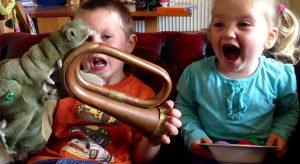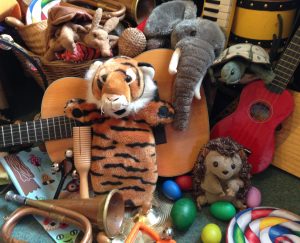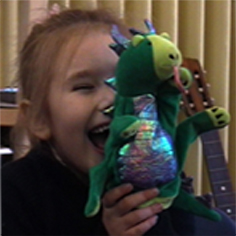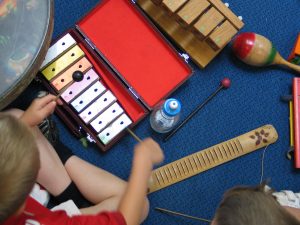 Mood Music, Mood Music, what mood are you in?
Mood Music, Mood Music, what mood are you in?
Mood Music offers a playful and contained way to begin to give shape and expression to what may be difficult emotional experiences. This article presents some songs and ways of using instruments which hit the spot for children.
Why focus on feelings?
Babies express their feelings to communicate what they need and want. When children get messages that their feelings aren’t ok, when they are rushed to move out of sadness, anger or fear, they begin to doubt and deny parts of themselves. All too often this develops into emotional and behavioural difficulties in later childhood, and then mental health issues in adult life.
When we listen to and match a child’s emotional experience with songs or music about their mood, we open up a ‘therapeutic moment’ when stuck emotions can move on. Put another way, we are offering input in the window of opportunity presented by a child’s interest. This is a natural part of child-centred practice – acknowledging and including what a child is feeling. This includes stuck expressions of feeling that might seem endless, like whining, aggression or pining for a parent. The good news is that accepting where we are actually helps us move on!
Daniel Goleman’s 1995 book of the same name introduced the idea of Emotional Intelligence – the ability to understand and make sense of what we feel. We have no choice about what we are feeling. But we do have a choice about whether we move away from our feelings or towards them. Do we try to ignore our difficult emotions and tell ourselves to function anyway, focussing on practical learning tasks? Or do we try to find words, music, movement, art or other experiences that give expression to our feelings, and find out more about them?
A key idea in this work is not judging – letting go of shoulds and shouldn’ts. Dan Hughes, a US Attachment Therapist, uses the acronym PLACE to summarise five key qualities he offers children in his work:
Play
Love
Acceptance
Compassion
Empathy
As well as music and songs, I’ve found that using puppets and sharing our own experiences help children move towards looking at themselves.
Naming feelings and their causes
The first step in learning about moods is recognising and naming them. You can use a puppet to model a mood, and all sing to it: Mood music, mood music, what mood are you in? Ask the children what they think its mood is, and discuss how they know (‘He’s crying’, ‘Her face looks cross’, ‘He’s using a grumpy voice’).
Then everyone can sing Why are you grumpy (or sad or scared)?’, and again ask the children for ideas. Accept every suggestion – they will all be representations of what’s in their lives.
Daily emotional check-in: Good morning Alfie, how are you? Giving children an opportunity to voice what’s going on for them – you can model it by sharing something about yourself.
A note about singing: if you’re wanting to sing phrases such as those above, or your own, then start with the two-note tune we all use when we call someone’s name – hey presto, you just became an improvising songwriter!
Labelling the mood behind the behaviour – Help children make the connection between how people act and what they’re feeling inside. You can use the tune of She’ll be coming round the mountain and change it to When I’m stomping round the house I’m feeling cross, or When I’m calling for my mum I’m feeling scared, or whatever the children come up with.
Four basic groups of emotions
: happy sad angry scared
Type of music: fast slow loud quiet
Actions: up down big small
Colour: green blue red yellow
Most feelings fit into these groups. You could brainstorm different moods with the children, to develop vocabulary and see which group they are part of. For instance excited, calm, joyful (happy); upset, miserable, down (sad); grumpy, cross, furious (angry); worried, anxious, frightened (scared).
Some moods just don’t fit into these categories – such as surprise, disgust, hunger.
 Feelings in the body
Feelings in the body
Emotions are expressed in the body – in our face, voice and posture.
Facial expression and voice: children love opportunities to make faces and put on voices. Mahachagogo is a fun rap (it’s spoken not sung) and a great game for this:
Leader: Followers:
When Mahachagogo is happy he says….[model voice and face/actions to fit the mood]
Mmmm Mmmm
Aaaah Aaaah
Ooooh Ooooh
Lah lah lah [sing-song voice] Lah lah lah
Then he stops. Why?
Because he’s not feeling happy any more, he’s feeling……..[wait for children’s suggestions….] And when he’s feeling……… [Start again in the new mood/feeling, making the same sounds but with different intonation]
Whole body moving
If you’re happy and you know it. This is a brilliant song, but the lyrics are somewhat emotionally challenged! So why not extend the words and do it as a standing up action song:
If you’re happy and you know it make a smile/have a dance…….
If you’re sad and you know it have a cry……..
If you’re angry and you know it stamp your feet…….
And so on – ask the children for action ideas, so that it might be different every time. A suggestion: finish with If you’re excited and you know it jump up and down, followed by If you’re tired and you know it go to sleep, to calm them down again.
Make your body…… Use this phrase and change the words to familiar songs, such as Old MacDonald: Make your body angry now, nng nng nng nng nng (instead of E-I-E-I-O.)
London Bridge is falling down: Make your body all feel sad
Differentiating feelings from behaviour
What we feel is distinct from what we do: whatever we feel may be unpleasant or painful but is intrinsically ok and can be welcomed, but behaviour can be judged as socially acceptable or otherwise. We’re looking here at the difference between expressing feelings and acting them out:
Do the right thing (to the tune of Allouette)
It’s ok to feel angry, and make an angry face
It’s ok to talk about it, feelings are ok
But….it’s not ok to hit, and it’s not ok to push
It’s not ok to bite – do the right thing
What you feel and what you do are two different things
Whatever you feel is ok, it’s all welcome here
But choose the right behaviour, do the right thing
Try to choose the right behaviour, do the right thing.
(Once the children are familiar with this song, you could discuss with them how to change the words, and sing your own version with different lists of things are that are ok (It’s ok to play angry music / stamp your feet….), and aren’t ok (It’s not ok to scratch / stamp on someone…..)
Mood Music aims to support the process of bringing the feeling further into awareness, so that it’s easier to make the choice about actions.
When a person (child or adult) is flooded with emotion, they are quite unable to make social choices. But they can often respond to an invitation to express that emotion in a contained way. And paradoxically, accepting and honouring the emotion that’s giving rise to unacceptable and stuck behaviour, helps children (and adults!) move on towards having more behavioural choices in their repertoire.
 Using puppets
Using puppets
Choose a puppet to represent the mood that you think a child is in, and make a story, sing a song, or ask the children why they might be in this mood. This is a non-threatening way to explore what you think is going on for the child. (Remember that we may be wrong in our guess of what a child’s mood is – it’s often better to approach it obliquely via a puppet, or ask questions, rather than saying “I can see you’re feeling scared”).
Another fun game is to use two puppets who are in very different moods, one on each hand. Sing a familiar song with the puppets taking turns to lead a line or two each, so that children have to change quickly from loud to quiet singing.
Working with children’s moods
When a child says they are missing mummy or daddy, I sing a song about it. Sometimes it’s something very simple and forgettable, such as Sad, sad, sad….. Or maybe I don’t sing, but just play slow music attempting to express a sad mood.
Over time, I have evolved templates of songs, which I adapt to the individual occasion, such as:
I miss my mummy
And I want my mummy
And I love my mummy
Mummy’s going to come and pick me up later
Then I’ll be feeling better
Or sometimes it feels more appropriate for the last line to stick with: But now I’m feeling sad
Case study: Ronnie chooses sad songs and music
Several weeks into his first term in nursery, Ronnie is still spending a lot of time looking very disconsolate and following an adult around. I catch his eye and sing a song about being sad, and he starts crying. I stop singing and say I’m sorry that he’s sad, and ask if he wants to sing a song. He nods, and I sing Baa Baa Black Sheep with him, then other songs, inviting him to choose, and matching the tentative quiet way he’s shaking a maraca then tapping a drum. I sing about ‘Some songs are happy, some songs are sad, some songs are loud, some songs are angry’, and he gradually starts to play louder, and I continue, mirroring him and literally going at his speed.
Later that day I’m with Ronnie and another child who is missing a parent, and I sing ‘Sad, sad, everybody has a bit of sadness, everybody’s sometimes sad’. They are both close to tears and I stop and ask if they want a loud song or a happy song or the sad song. They both want the sad song, so I continue.
Ronnie became familiar with my responses to his sadness, and seemed to come to me because he was missing his mummy or daddy, and tell me about it. So then part of my response is ‘Would you like to play sad music, or happy music?’, and he often says ‘Sad music’, and we play or I sing in that vein. The room leader passed us in the garden one day making our sad music, and understandably encouraged him to sing a jolly song, and I explained that it was his choice to make sad music.
In making this choice, Ronnie is doing exactly the same thing that we do as adults: most of us have some poignant music or songs amongst our favourites. We return to this music at times of heartbreak or depression, to help us find the shape of what we’re going through and live with it. Yet we often offer children a saccharine musical world full of only happiness!
Calming activities
I use a meditation bell, or a candle (in winter), or both together, to help children focus calmly amidst the busyness of the day. You probably have instruments you can use to help this, such as chime bars, indian bells, or a ukulele played gently and slowly. This could be part of a story about a puppet having a rest, or the children lying down.

Using instruments
Led activities
- Introduce a puppet who is in a particular mood, and choose instruments with the children which will make appropriate sounds for its mood. (You can widen your repertoire of sounds by using voices and found objects as well as designated instruments.) Next time use a different puppet and make music for its mood. Over time you can start to tell simple stories using various puppets interacting with each other. My stories like this are often simply ‘Once there was an angry tiger……..and he met a scared turtle…….and then there was a happy rabbit’.
- Sing a familiar song, all using instruments, and sing it in different ways, using loud/quiet/fast/slow music for angry/scared/happy/sad.
Responding to children’s music explorations – MIRRORing
When children are making their own music, listen to the feeling in the sound they’re making, as well as the rhythms or notes. Sometimes the best response is to just observe, but if it feels right then join in with them without adding anything. When you do this, think of the acronym MIRROR:
Match
Imitate
Reflect
Respect
Observe
Repeat
This is the best sort of instrumental tuition you can give a pre-school child – you are showing them that what they’re doing is interesting and important, and not rushing them prematurely into ideas of ‘getting it right’.
Note that mirroring is not the same as parroting – when we parrot we are not using our human qualities of empathy, compassion and respect.
Sometimes it feels right to add to the music children are making, by singing or playing something additional. You are the judge of when it feels right to do this.
To listen and download songs go to www.playit.bandcamp.com.
